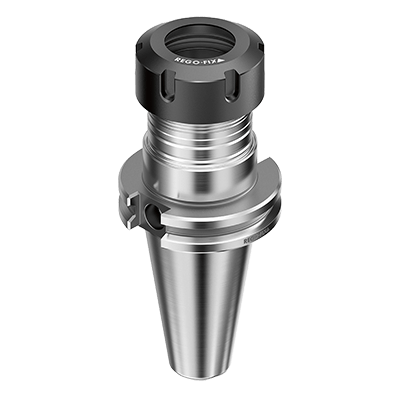Now days, it seems every shop has its own preferences when it comes to types of machine spindle interfaces, and among those, the most common are steep taper CAT, HSK and CAPTO type interfaces. While each has its own benefits and shortcomings, all fulfill specific machining application and tool holding needs.

Easy availability is often the key reason many shops opt for for CAT or steep-taper type interfaces. Practically every machine tool builder and tool holder manufacturer offers their products in a CAT version.
The downside with a CAT interface, however, is taper accuracy. In terms of repeatability, the issue is how much that interface deviates from one holder clamping to the next as far as the centerline of the taper is concerned.
For instance, a regular CAT holder can exhibit about 5 microns of tolerance from clamp to clamp, and this is simply because of the inherent nature of the taper design. Adding to this are the threaded pull studs used to secure CAT type holders in the machine spindle.
So what does this mean for the end user? It means they could clamp a tool holder into a CAT interface 20 times and may experience anywhere from zero difference between holder clampings to as much as 10 microns – a variation that is perfectly acceptable in most applications.
On the plus side, the CAT interface has long been the go-to for strong tool holding and aggressive machining applications. However, with the advent of BIG-PLUS-type holders, most shops are realizing that full contact clamping – both at the taper and on the external spindle face – ensure as much as two to three times more rigidity and secure clamping for heavy material removal operations while also improving clamp to clamp tolerances. Both CAT and BIG-PLUS type holders are best used for general purpose machining and not often for high spindle speeds or super high accuracy.
As with BIG-PLUS, the concept of full tool holder clamping contact has escalated the popularity of HSK spindle interfaces that provide even more rigidity when compared to both CAT and BIG-PLUS type holders. HSK tapers are shorter, and the holders weigh less, all of which translates into faster and less cumbersome tool changes. Automatic tool changers don’t have to move as far for clearance to swing in a tool, and shops avoid having to decide which pull stud to use among the hundreds available because the HSK shape is what secures holders in place.
When it comes to repeatability, the HSK interface provides clamp-to-clamp accuracy within 3 microns, which increases overall machining precision. This accuracy makes HSK holders well suited for high spindle speed, high feed rate and multiple pass machining. At 30,000- to 60,000- rpm spindle speeds for, example, the holders maintain 0.1 or better tolerances at the tool tip.
With the advent of mill-turn/multi-tasking machines, an increasing number of shops are finding more applications for the CAPTO-type spindle interface that continues to grow in popularity. When one considers a mill-turn machine, most builders offer them in either CAPTO or HSK interface versions.
The CAPTO interface with full contact clamping excels at higher torque transmission situations and provides exceptional repeatability. While the interface delivers a 3-micron tolerance, its design’s three large lobes are what allow holders to easily handle high torque transmission.
Regardless of spindle interface type, REGO-FIX offers tool holders and system options for virtually every machining need. Our HSK powRgrip is perfectly suited for high accuracy, torque and speed applications. The micRun system provides high accuracy for low-torque machining applications, and the standard REGO-FIX ER holding system would be all their application requires.
